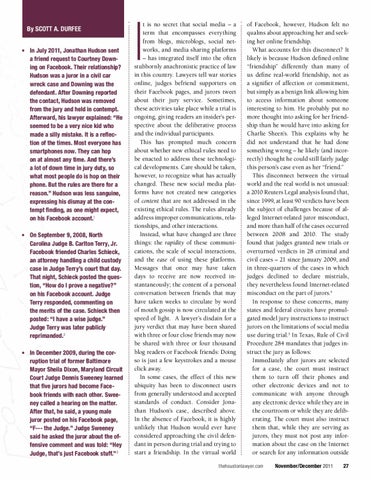By Scott A. Durfee • In July 2011, Jonathan Hudson sent a friend request to Courtney Downing on Facebook. Their relationship? Hudson was a juror in a civil car wreck case and Downing was the defendant. After Downing reported the contact, Hudson was removed from the jury and held in contempt. Afterward, his lawyer explained: “He seemed to be a very nice kid who made a silly mistake. It is a reflection of the times. Most everyone has smartphones now. They can hop on at almost any time. And there’s a lot of down time in jury duty, so what most people do is hop on their phone. But the rules are there for a reason.” Hudson was less sanguine, expressing his dismay at the contempt finding, as one might expect, on his Facebook account.1 • On September 9, 2008, North Carolina Judge B. Carlton Terry, Jr. Facebook friended Charles Schieck, an attorney handling a child custody case in Judge Terry’s court that day. That night, Schieck posted the question, “How do I prove a negative?” on his Facebook account. Judge Terry responded, commenting on the merits of the case. Schieck then posted: “I have a wise judge.” Judge Terry was later publicly reprimanded.2 • In December 2009, during the corruption trial of former Baltimore Mayor Sheila Dixon, Maryland Circuit Court Judge Dennis Sweeney learned that five jurors had become Facebook friends with each other. Sweeney called a hearing on the matter. After that, he said, a young male juror posted on his Facebook page, “F--- the Judge.” Judge Sweeney said he asked the juror about the offensive comment and was told: “Hey Judge, that’s just Facebook stuff.” 3
I
t is no secret that social media – a term that encompasses everything from blogs, microblogs, social networks, and media sharing platforms – has integrated itself into the often stubbornly anachronistic practice of law in this country. Lawyers tell war stories online, judges befriend supporters on their Facebook pages, and jurors tweet about their jury service. Sometimes, these activities take place while a trial is ongoing, giving readers an insider’s perspective about the deliberative process and the individual participants. This has prompted much concern about whether new ethical rules need to be enacted to address these technological developments. Care should be taken, however, to recognize what has actually changed. These new social media platforms have not created new categories of content that are not addressed in the existing ethical rules. The rules already address improper communications, relationships, and other interactions. Instead, what have changed are three things: the rapidity of these communications, the scale of social interactions, and the ease of using these platforms. Messages that once may have taken days to receive are now received instantaneously; the content of a personal conversation between friends that may have taken weeks to circulate by word of mouth gossip is now circulated at the speed of light. A lawyer’s disdain for a jury verdict that may have been shared with three or four close friends may now be shared with three or four thousand blog readers or Facebook friends: Doing so is just a few keystrokes and a mouse click away. In some cases, the effect of this new ubiquity has been to disconnect users from generally understood and accepted standards of conduct. Consider Jonathan Hudson’s case, described above. In the absence of Facebook, it is highly unlikely that Hudson would ever have considered approaching the civil defendant in person during trial and trying to start a friendship. In the virtual world
of Facebook, however, Hudson felt no qualms about approaching her and seeking her online friendship. What accounts for this disconnect? It likely is because Hudson defined online “friendship” differently than many of us define real-world friendship, not as a signifier of affection or commitment, but simply as a benign link allowing him to access information about someone interesting to him. He probably put no more thought into asking for her friendship than he would have into asking for Charlie Sheen’s. This explains why he did not understand that he had done something wrong – he likely (and incorrectly) thought he could still fairly judge this person’s case even as her “friend.” This disconnect between the virtual world and the real world is not unusual: a 2010 Reuters Legal analysis found that, since 1999, at least 90 verdicts have been the subject of challenges because of alleged Internet-related juror misconduct, and more than half of the cases occurred between 2008 and 2010. The study found that judges granted new trials or overturned verdicts in 28 criminal and civil cases – 21 since January 2009, and in three-quarters of the cases in which judges declined to declare mistrials, they nevertheless found Internet-related misconduct on the part of jurors.4 In response to these concerns, many states and federal circuits have promulgated model jury instructions to instruct jurors on the limitations of social media use during trial.5 In Texas, Rule of Civil Procedure 284 mandates that judges instruct the jury as follows: Immediately after jurors are selected for a case, the court must instruct them to turn off their phones and other electronic devices and not to communicate with anyone through any electronic device while they are in the courtroom or while they are deliberating. The court must also instruct them that, while they are serving as jurors, they must not post any information about the case on the Internet or search for any information outside
thehoustonlawyer.com
November/December 2011
27
